The Taieri Gorge train ride has been called “one of the world’s great train trips”. The 154km trip involves a journey through the wild, rugged gorge that Victorian grit and determination managed to conquer with a dramatic rail line connecting Dunedin to the Central Otago town of Cromwell.
ENGINEERING MARVEL
Construction began on the Central Otago railway line in June 1879 and it took a staggering 12 years to complete the first 65 kilometres, then a further 30 years to complete the line all the way to Cromwell. When you discover there are 35 bridges and viaducts as well as 12 tunnels in the Taieri Gorge, the long construction time makes some sense, especially when it was all done with pick and shovel. Thousands of tons of hard schist rock had to be blasted to form the bed for the rails. Expert stonemasons then cut and shaped this sharp rock to build the beautiful buttresses and piers that make this rail trip so interesting.
MY TRIP
There are a number of things I remember from my trip on the Taieri Gorge Railway. The 6 carriages comprising the train were a mixture of 1920s era wooden ones and refurbished 1930 era steel units. In busy times, the train can have as many as14 carriages. The brown and yellow colour scheme is not particularly striking. To me, it would make sense to replace the muddy brown with a deep blue. Why? These are the colours of Otago and also the combination of blue and yellow would look more stylish than the current yellow and brown which I think, and others I’ve spoken to agree, lacks eye appeal. The locomotives are blue and gold so why not the rest of the train in the same colours?
The train moves slowly but that’s okay as it is a tourist trip and I’m sure the organizers at Dunedin Rail have worked out the schedule and timings to meet demand. The first tunnel after leaving the magnificent Dunedin Railway Station is at Caversham. (there will be a separate blog on the Dunedin Railway Station) Shortly after passing through the Caversham Tunnel the train enters the Wingatui Tunnel. The attractive little station at Wingatui is a magnet for photographers and I noticed a number of fellow travellers eager to take a pic. The station was refurbished and painted in 2009 and is now a great example of a country station found across New Zealand at the height of railway popularity in the 1920s.
Although it was a cool day, I shared an outdoor platform at the back of my carriage with visitors from Germany, Canada and Hong Kong. We wanted to be closer to the countryside and to enjoy the sweet scent of damp grass in the paddocks as we crossed the Taieri Plain on the way to the Taieri Gorge. Once in the gorge, the temperature dropped but this didn’t drive any of us into the carriages.
VIADUCTS AND TUNNELS
In my opinion, the Wingatui Viaduct is the most impressive structure on the whole trip. Built in 1887, this 197 metre long bridge is the largest wrought iron viaduct in the southern hemisphere. I have actually flown UNDER it in a helicopter while making a big screen film on Otago. I am possibly the only person around, apart from the pilot, to have experienced this dangerous exploit and it did give me a unique perspective on just how large this viaduct is. It towers over the rocky Mullocky Gully and, like other engineering marvels in the Taieri Gorge, it must have been a shockingly difficult project to complete with the primitive tools available at the time. To me, it’s amazing it is still standing and carrying trains. The long trains during the busy season need 3 heavy diesel locomotives to pull them. Imagine the weight the bridge has to support!
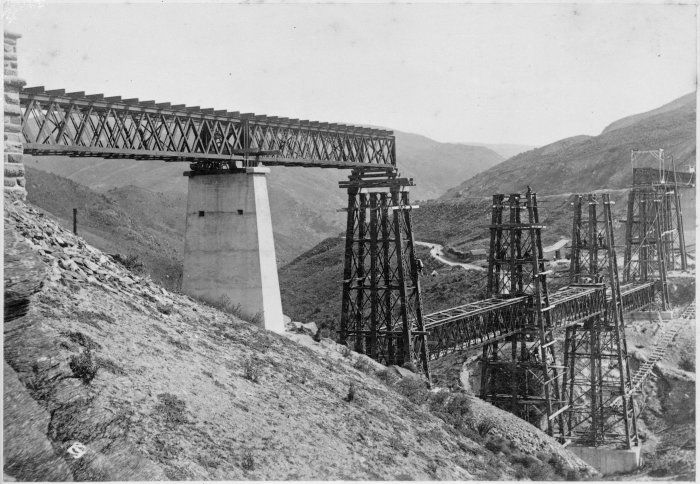 Wingatui Viaduct under construction 1887
Wingatui Viaduct under construction 1887
RUGGED LANDSCAPE
A gorge is described as a deep narrow valley with steep sides, with a river flowing along the floor of the valley. The dark trees crowding the steep hills in the Taieri Gorge, along with the shear drop to the Taieri River and the grey stone canyons along the way, gave me a feeling of unease. I could easily imagine the ghosts of those men who died building the line, wandering about when mist fills the gorge. There didn’t seem to be any way to escape if we broke down but I was assured the locomotives are well maintained at their own workshop in Dunedin. A warm cup of tea helped put my thoughts back on track.
The tunnels along the line were built to accommodate 19th century trains which were smaller than modern ones, so they are really narrow. I noticed this as we approached the Duck Point Tunnel. It’s a case of just inches between the tunnel’s wall and the train. It almost makes you hold your breath as the train eases itself into the black interior.
ISOLATED HOUSE
In the middle of the gorge, it was a real surprise to pass a well kept house with a little garden and mown lawn nestled between the railway and the river. It has to be one of the most isolated houses in New Zealand. Thoughts I had about no escape earlier, returned. The owners have to access their house by either walking through the tunnel or negotiating a track over the top of it. The same family have owned the house since the 1950s so I guess they are happy with the odd location and difficult access. I couldn’t imagine living there, even for one night! The freezing winters would only add to the feeling of isolation but to each his own!
WALKABOUT
The train stopped at Hindon to allow the passengers to step off and admire the surrounding landscape. The Hindon Station is a modern little shed that doesn’t really warrant the title of ‘station’. A statue in front of it is dedicated to a collie dog called Sue. However, the statue also commemorates all collie dogs who have worked in the area since the arrival of European farmers 150 years ago. I noticed the overseas tourists used the memorial for selfies. It didn’t attract the same interest from fellow Kiwi passengers. However, I thought it was a lovely sentiment and it definitely adds a point of interest to the brief stop.
BEAUTIFUL STONE WORK
One of the most visually appealing viaducts in the Taieri Gorge is the one spanning Deep Stream. This is because the stone supports are tapered to give the viaduct a really graceful appearance. It’s amazing the effort the Victorian builders went to, and the pride they took in their work.
I was told before taking the trip that The Notches were a highlight. As it turned out, they certainly were amazing. The railway was built through and over this particularly difficult part of the gorge. Within just one kilometre, two viaducts and three bridges carry the tracks ahead. Standing on the outside platform of my carriage was a thrilling experience as the train hugged the side of the cliffs with no room between the railway and the river below. It reminded me a little of the narrowest parts of the Skippers Road, one of the most dangerous roads in the world.
The train trip ended at Pukerangi. I have to say, this is a real anti climax. There is nothing there but a bland shed standing in for a station. Some of my fellow passengers also voiced their disappointment. Apparently, the stop is a connection for those doing the circuit via the Seasider rail trip but it is still a no-man’s-land stop. The Taieri Gorge Railway does travel on to Middlemarch two days a week and this is a more satisfying ending to the trip. At least Middlemarch has a busy station. There is a lovely little hotel and some cafes to enjoy as well. Middlemarch has become a vibrant rural town as it is the eastern start to the internationally popular Otago Rail Trail. (I have featured this trail in my bloghttps://hewardblog.com/the-best-cycle-trails-on-earth/
The Taieri Gorge Railway is a memorable experience. It offers a glimpse of a different New Zealand landscape. It is a real change from the rolling green hills, dramatic mountains and lakes and glistening beaches that are usually shown to promote New Zealand to the world. In my opinion, the attraction of this rail trip is riding over and through the spectacular engineering feats undertaken by hundreds of men who toiled in hellish conditions in the late 19th century to build a railway in such a hostile landscape. With this in mind, it is truly a unique New Zealand rail trip.
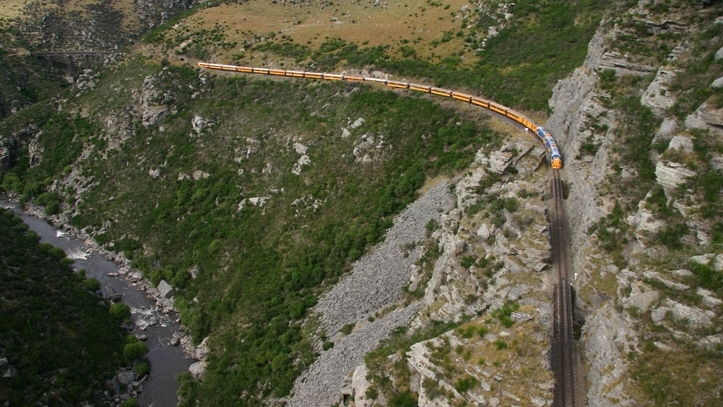 This short video takes you on the trip.https://www.youtube.com/watch?v=-oiYckEcoyY
This short video takes you on the trip.https://www.youtube.com/watch?v=-oiYckEcoyY
Dunedin Rail also operates The Seasider. In my opinion, this is the most spectacular train trip in the southern hemisphere. The seascapes glimpsed along the way are simply breathtaking. I’ll leave this amazing train trip to another blog.
Ceidrik Heward
Ceidrik Heward is an Amazon TOP SELLING AUTHOR and has lived and worked in 7 countries working as a TV cameraman, director and film tutor. For the past 17 years he has focused on writing and has been published in magazines and newspapers in Europe, USA, Asia and the Middle East.
His interests include photography, psychology and metaphysics. He loves to read and always has at least 3 books on the go. He has written 22 manuals/books and has just completed his 4th short novel. Ceidrik believes sharing information and stories is the best way to stimulate the imagination and enrich our lives.

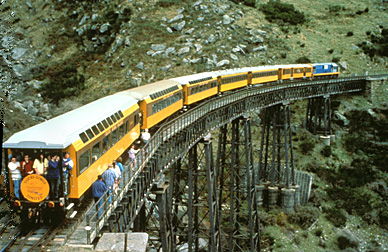
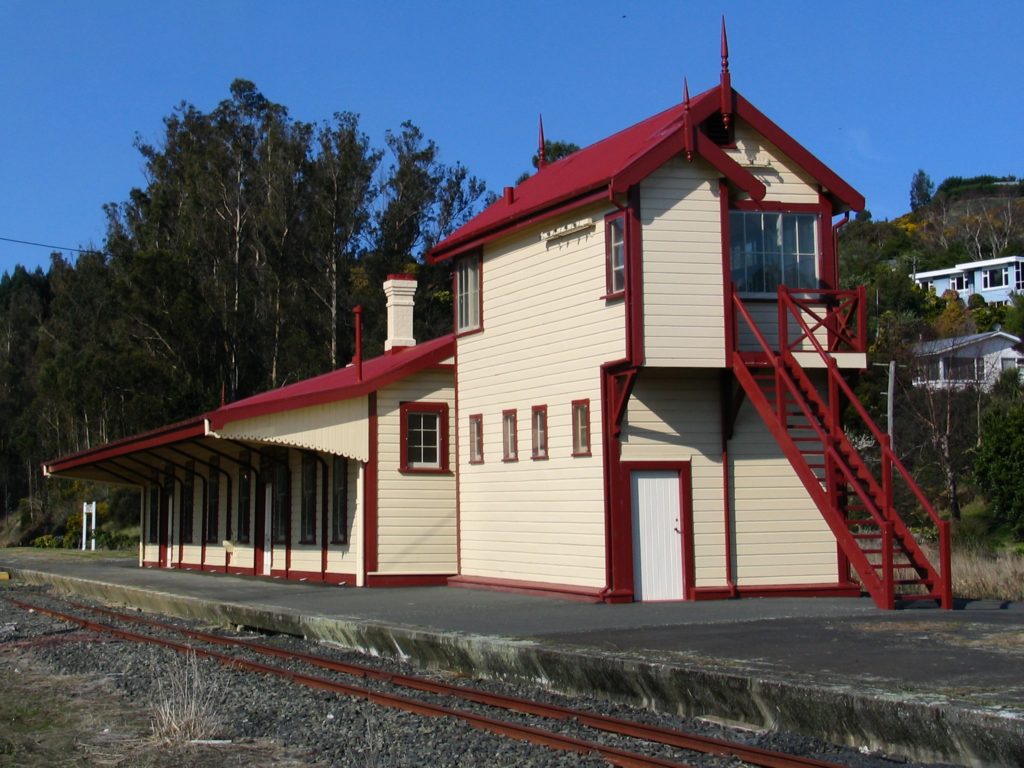



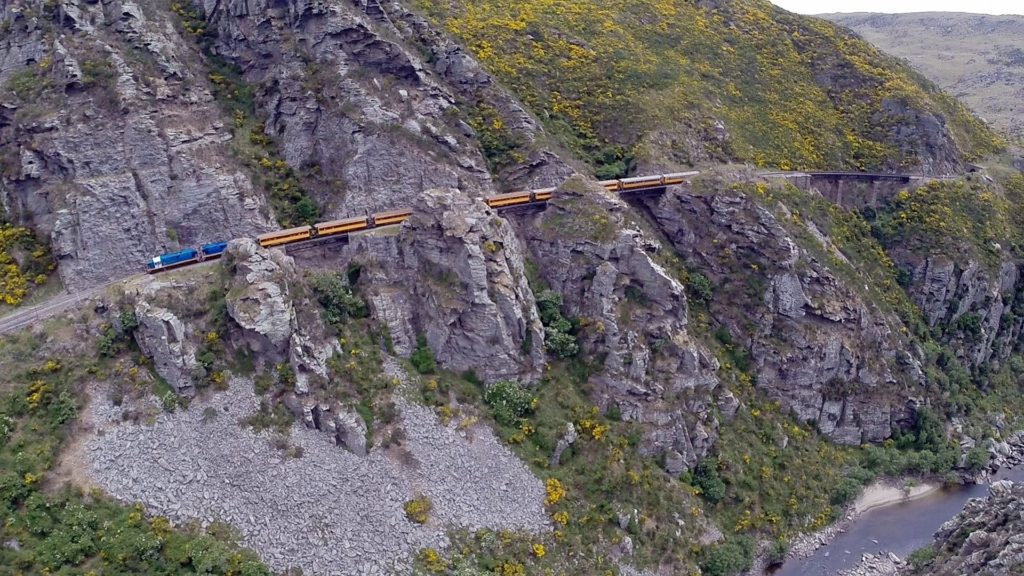




















 Visit Today : 532
Visit Today : 532 Total Visit : 1133709
Total Visit : 1133709
Speak Your Mind